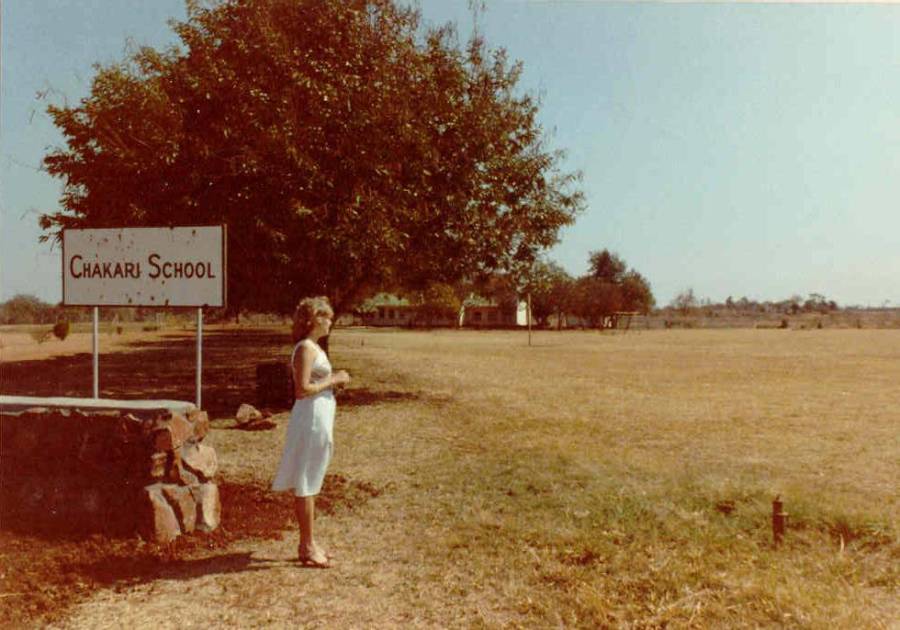CHAKARI

Jenny Poultney (nee Tanner) attended Chakari School in the early 60s and then was posted there for her first
teaching job out of Bulawayo TTC in 1979 !
Rhodesian Place Names
CHAKARI

Jenny Poultney (nee Tanner) attended Chakari School in the early
60s and then was posted there for her first
teaching job out of Bulawayo TTC in 1979 !
Latitude 18° 04’ S; Longitude 29° 52’ E; Altitude
1,090 m (3,600 ft); Rainfall 760 mm (30 in)
Chakari, a village 21 miles north east of Gatooma, is one of
those places which has undergone a number of name changes during
its existence. It was first known, in 1907, as Turkois Mine, but
this was changed in 1911 to Shagari. Owing to the difficulty some
Europeans have in pronouncing the African language, it became
obvious that the name should have been Chakari, and not Shagari.
It was accordingly decided to alter it once more and on July
1,1923 it officially became known as Chakari.
The area produces maize, tobacco and cotton, but perhaps the most
important activity is mining. The largest mines are the Dalny and
Turkois, which have been important producers of gold for many
years. The Turkois mine was pegged by Llewellyn Lloyd on June
20,1909, but the claims were subsequently acquired by the
Rhodesian Development Corporation.
The first Dalny claim was pegged on November 5,1905, by the
Rhodesian Exploration and Development Company, and a parallel
reef was pegged on November 5,1895, by the Great B Syndicate. The
first production was recorded in 1910. The Great B Syndicate was
composed of three men, Jack Mack of the Golden Valley Mine,
Charlie Bennett, a geologist and Ralf Sears of the Owl Mine.
Although the syndicate tried hard to make the mine pay, the
refractory nature of the ore made gold extraction with limited
knowledge and equipment uneconomical.
Many men in the intervening years tried without success to make
the Dalny pay. In 1914, Kerk and Rork had the Dalny on tribute
from the Great B Syndicate. They left their claims to take part
in the War and both lost their lives while at the front. In 1920,
an Australian, named McDonald and his partner, Sale, took out a
tribute from the syndicate, and invested in a 5-stamp mill, but
were also beaten by the problems of extraction. They only went
down some 15 metres in the stopes over a period of some four
years, and never obtained better than about 4-5 dwts. of gold per
ton. In 1924, John Mack and Tom Golding put down some boreholes,
and in doing so intersected some ore bodies, but John Mack stood
down at this stage and left the mine to his friend, who, however,
met with no success.
In 1945, Rix, a consulting engineer for the Falcon Mines
expressed the view that, worked properly, and provided the
concentrates were roasted, the Dalny Mine, together with other
mines in the area, could become a viable proposition. The Falcon
Mines, therefore started negotiations with Tom Golding and Jack
Mack, as a result of which it was decided to purchase the
property from the Rhodesian Development Corporation, which
included the Turkois Mine and the Corporation's interest in the
other claims. The purchase price was agreed upon as being the
issue of 250,000 fully paid-up shares of 50c each in the capital
of the Company.
The results of the mine's development have proved successful, and
during the first five months of operation under the new owners,
from about 100,000 tonnes of ore milled, nearly 19 000 ounces of
gold was recovered.
Return to Rhodesian Place Names
This page is maintained by
Gordon Poultney
Most of the information on this page is
extracted from the books :
"Avondale to Zimbabwe" written and published by R.
Cherer Smith ISBN 0-7974-0313-2 and
"Tabex Encyclopedia Zimbabwe" © Quest Publishing
ISBN 0-908306-04-0
with additional notes and photographs by the webmaster and other
contributors as acknowledged.